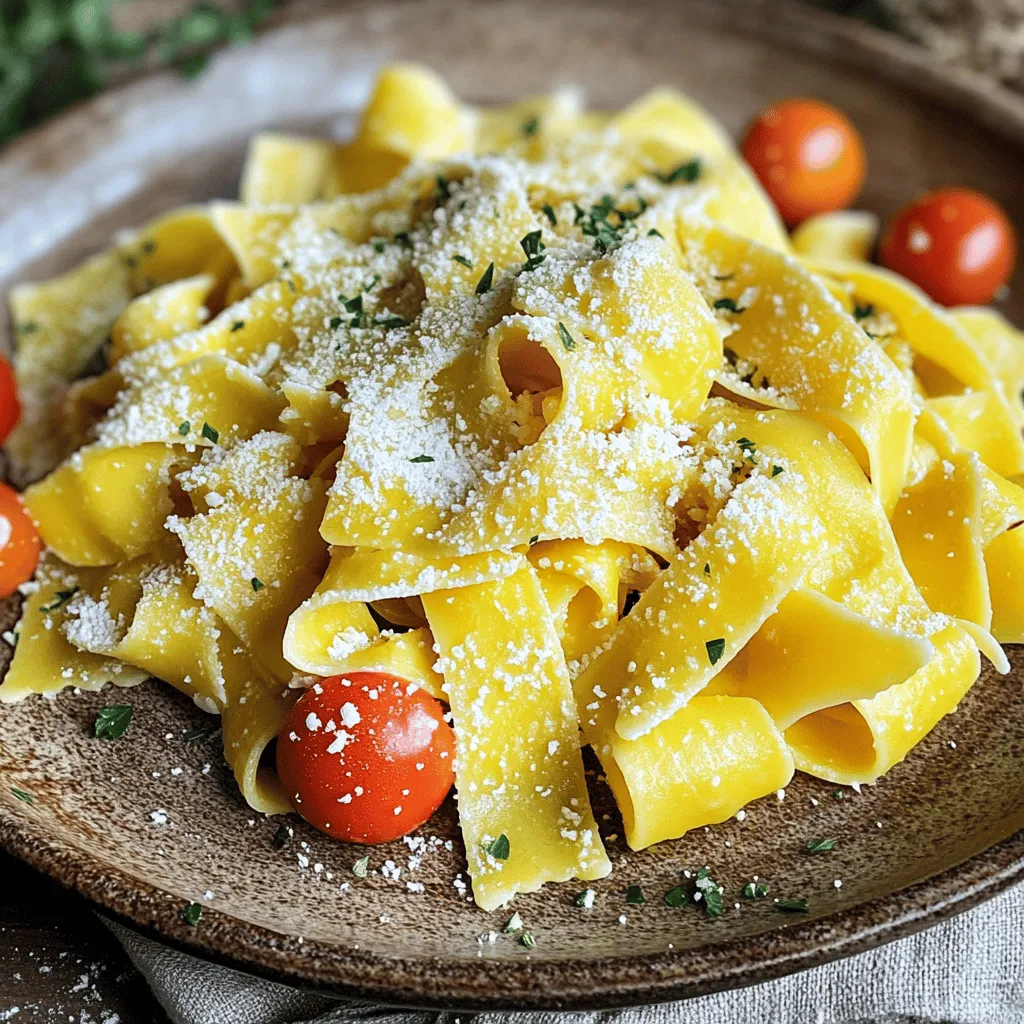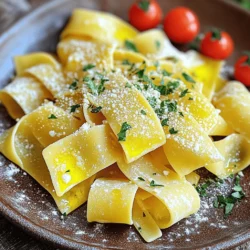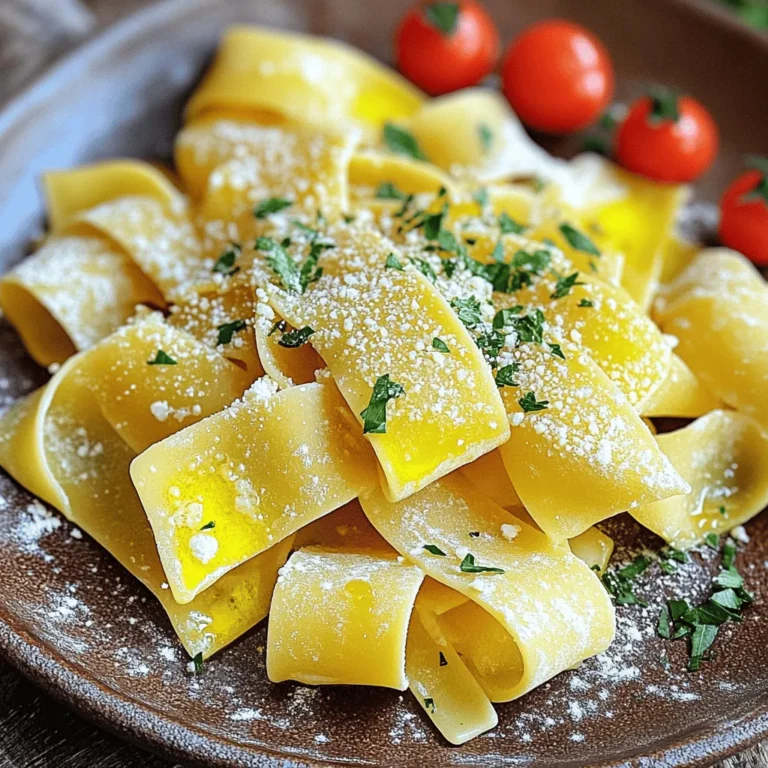Are you ready to elevate your pasta game? Homemade sourdough pasta is not just a dish—it’s an experience. With just a few fresh ingredients, you can craft a flavorful, chewy pasta that will impress your family and friends. I’ll guide you step-by-step, sharing tips and tricks to help you create pasta that’s simple and delicious. Let’s dive into the world of sourdough pasta and transform your meals today!
Ingredients
Required Ingredients for Homemade Sourdough Pasta
To make delicious homemade sourdough pasta, you need the following ingredients:
– 2 cups all-purpose flour
– 1 cup sourdough starter (well-fed and bubbly)
– 1 large egg
– 1 teaspoon salt
– 1 tablespoon olive oil
– Water (as needed for dough consistency)
These ingredients come together to create a rich and unique flavor. The sourdough starter adds depth to your pasta.
Tips for Selecting Fresh Ingredients
When picking your ingredients, freshness is key. Here are my top tips:
– Flour: Choose high-quality all-purpose flour. Look for a brand that feels soft and fine.
– Sourdough Starter: Use a bubbly starter. This shows it is active and ready.
– Eggs: Select eggs with bright yolks. This indicates freshness and adds color.
– Olive Oil: Go for extra virgin olive oil. It enhances the flavor of your pasta.
Fresh ingredients make a big difference in taste. Always check for signs of freshness before buying.
Optional Add-ins for Enhanced Flavor
You can boost your pasta with these optional add-ins:
– Herbs: Add finely chopped fresh herbs like basil or parsley. They bring a nice aroma.
– Spices: A pinch of nutmeg or black pepper adds warmth and spice.
– Cheese: Grated Parmesan can be mixed into the dough for richness.
These add-ins can personalize your pasta and make it even more special. Feel free to experiment!
Step-by-Step Instructions
Preparation of the Dough
To start, gather your ingredients. You will need:
– 2 cups all-purpose flour
– 1 cup sourdough starter (well-fed and bubbly)
– 1 large egg
– 1 teaspoon salt
– 1 tablespoon olive oil
– Water (as needed for dough consistency)
First, combine the flour and salt in a large bowl. Mix them well with a whisk. Next, make a deep well in the center of the flour. Pour in the sourdough starter, crack in the egg, and add the olive oil.
Use a fork to mix the wet and dry ingredients. Slowly pull the flour into the wet mix until the dough comes together. If it’s too dry, add water a little at a time. Once it forms a shaggy ball, move it to a floured surface.
Knead the dough for about 8-10 minutes. Work it until it feels smooth and elastic. If it sticks, just add more flour. Shape your dough into a ball, wrap it tightly in plastic, and let it rest for 30 minutes. This step helps the dough become easier to roll out.
Rolling and Cutting Techniques
After the dough rests, divide it into four pieces. Keep the other pieces covered to avoid drying out. Take one piece and flatten it with your hands. You can use a pasta machine or a rolling pin to roll it out. Aim for a thinness you like, dusting with flour as needed.
Once rolled, cut the pasta into your favorite shapes. You can make fettuccine, tagliatelle, or even lasagna sheets. Sprinkle a little flour on the cut pasta to prevent it from sticking together.
Cooking the Fresh Pasta
Now, it’s time to cook your fresh pasta. Bring a large pot of salted water to a boil. Carefully add your pasta to the pot. Cook it for 2-4 minutes, checking it often. Fresh pasta cooks much faster than dried pasta, so keep an eye on it!
When it’s done, drain the pasta and toss it with your favorite sauce. You can add sautéed veggies or a drizzle of olive oil for a tasty meal. Enjoy your homemade sourdough pasta!
Tips & Tricks
Troubleshooting Common Issues
When making homemade sourdough pasta, you might face some issues. If your dough is too dry, add water one tablespoon at a time. If it is too sticky, sprinkle more flour as you knead. A rough texture means you did not knead enough. Keep kneading until it feels smooth and elastic. If the pasta tears while rolling, it might need more resting time. Let it rest longer to relax the gluten.
Best Practices for Kneading and Resting Dough
Kneading is key for good pasta. Use your hands and push down on the dough. Fold it over and repeat. Knead for about 8-10 minutes. This builds strength and helps the pasta hold its shape. After kneading, wrap the dough in plastic wrap. Let it rest for at least 30 minutes. This step helps the gluten relax, making it easier to roll later.
How to Achieve the Perfect Pasta Texture
The texture of your pasta should be smooth and soft. When rolling out the dough, aim for a thin layer. Dust with flour as needed to prevent sticking. If you prefer a thicker pasta, adjust your rolling. A perfectly rolled pasta should feel silky. When cooking, al dente is the goal. It should be firm but not hard. Check it often as fresh pasta cooks quickly, usually in 2-4 minutes.

Variations
Different Shapes and Sizes of Sourdough Pasta
You can make sourdough pasta in many shapes. Each shape gives a new look and feel to your dish. Here are some fun options:
– Fettuccine: This flat pasta is great for thick sauces.
– Tagliatelle: Slightly wider than fettuccine, it holds sauce well.
– Lasagna sheets: Perfect for layered dishes with sauce and cheese.
– Pappardelle: Wide ribbons that are great with hearty sauces.
Try different shapes based on your mood or the sauce you want to use. Each shape works well with different types of meals.
Flavor Variations: Herbs and Spices
You can add herbs and spices to your sourdough pasta dough. This makes your pasta even tastier. Here are some ideas:
– Basil: Adds a fresh, sweet flavor.
– Oregano: Gives a warm, earthy taste.
– Garlic powder: Adds a nice kick.
– Black pepper: A must for a little heat.
Simply mix a teaspoon of dried herbs or spices into the flour before adding the wet ingredients. This way, your pasta has a burst of flavor in every bite.
Homemade Sauces Complementing Sourdough Pasta
Homemade sauces can elevate your sourdough pasta. Here are a few simple ideas:
– Tomato sauce: A classic choice. Cook tomatoes with garlic and herbs.
– Pesto: Blend basil, pine nuts, garlic, and olive oil. This sauce is fresh and bright.
– Alfredo: Mix cream, butter, and Parmesan cheese for a rich sauce.
– Olive oil and garlic: Sauté garlic in olive oil for a light, tasty option.
These sauces will make your pasta shine. Try different combinations to find your favorite!
Storage Info
Storing Uncooked Pasta for Later Use
You can store uncooked sourdough pasta easily. First, dust the pasta with flour to prevent sticking. Then, lay the pasta flat on a baking sheet. Make sure the strands do not touch. Cover it with plastic wrap and place it in the fridge. It stays fresh for up to two days. If you need to store it longer, consider freezing.
Freezing Techniques for Fresh Pasta
To freeze fresh pasta, follow these steps:
– First, dust the pasta with flour.
– Next, place it in a single layer on a baking sheet.
– Freeze the pasta for about 30 minutes.
– Once firm, transfer the pasta into a freezer bag.
– Remove as much air as possible before sealing.
This method helps prevent the pasta from clumping together. Frozen pasta can last for up to three months. When ready to cook, do not thaw. Just drop it directly into boiling water.
Best Practices for Storing Cooked Sourdough Pasta
After cooking sourdough pasta, it’s best to store it properly. Toss it lightly with olive oil to keep it from sticking. Place it in an airtight container. You can keep it in the fridge for up to three days. When reheating, use a pan over low heat with a splash of water. This keeps it moist and tasty. Avoid microwaving, as it can make the pasta tough.
FAQs
Can I use whole wheat flour for sourdough pasta?
Yes, you can use whole wheat flour. This will give your pasta a nutty flavor and a denser texture. Mix it with all-purpose flour for a better balance. Start with a 50/50 ratio and adjust based on your taste.
How long does homemade sourdough pasta last?
Homemade sourdough pasta can last 2-3 days in the fridge when stored in an airtight container. If you freeze it, it can last for up to 3 months. Just make sure to separate the pieces with flour to prevent sticking.
What can I serve with sourdough pasta?
You can serve it with a variety of sauces. Consider classic marinara, creamy Alfredo, or even a simple garlic and olive oil mix. Adding sautéed vegetables or fresh herbs enhances the dish’s flavor and color.
Is sourdough pasta healthier than regular pasta?
Sourdough pasta can be healthier. The fermentation process makes it easier to digest. It may also lower blood sugar spikes. Whole wheat flour adds fiber, making it a better choice than regular flour.
How do I make gluten-free sourdough pasta?
To make gluten-free sourdough pasta, use gluten-free flour blends. Combine it with your well-fed sourdough starter and an egg. You might need to adjust the amount of water to get the right dough consistency.
Making homemade sourdough pasta is fun and rewarding. You learned about essential ingredients, preparation steps, and how to troubleshoot issues. Remember to choose fresh ingredients and experiment with flavors. Try different pasta shapes and sauces for variety. Storing your pasta correctly helps keep it fresh for later use. With these tips and techniques, you can create delicious, homemade meals. Now, it’s time to make your sourdough pasta dreams a reality! Enjoy the process and share your skills with friends and family.


